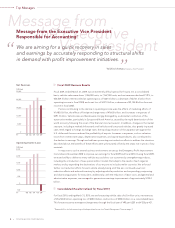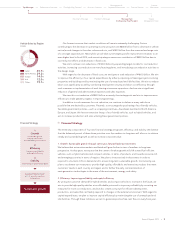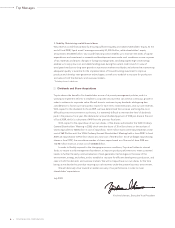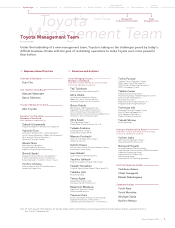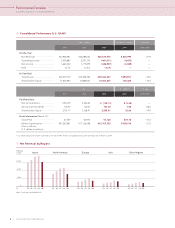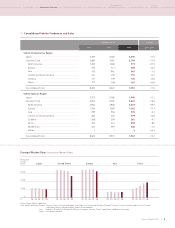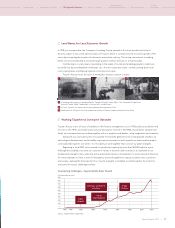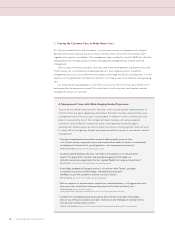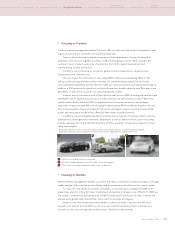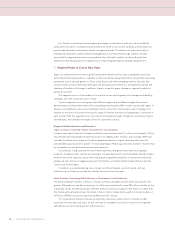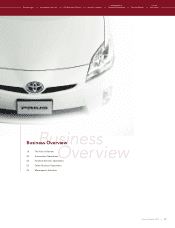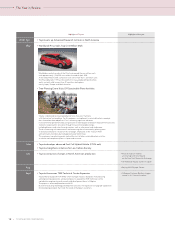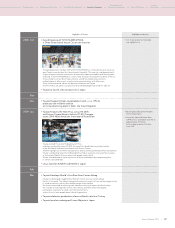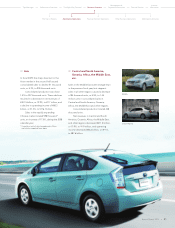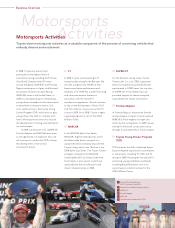Toyota 2009 Annual Report Download - page 16
Download and view the complete annual report
Please find page 16 of the 2009 Toyota annual report below. You can navigate through the pages in the report by either clicking on the pages listed below, or by using the keyword search tool below to find specific information within the annual report.
For Toyota to implement optimal regional strategies under these conditions, we must identify
areas where we want to compete and areas where we need to move more carefully, and revitalize our
product development and lineup to better suit regional needs. To enable us to respond nimbly to
change and implement market-oriented management in a timely and thorough manner, we have
appointed five regional executive vice presidents who will watch markets closely, and apply their
expertise to the development of a regional vision that will guide regional strategy development.
Regional Vision to Create New Value
Signs of a medium-term recovery in global automobile demand can be seen in gradually improving
automobile financing operations, a greater number of vehicles being retired from service than are being
purchased, and continued growth in China, India, Brazil, and other emerging markets. But new fuel
controls aimed at environmental preservation are anticipated, and there is a strong likelihood that the
structure of markets will change. In addition, there is a need to grasp changes in regional markets as
quickly as possible.
Our regional vision is the foundation from which we can quickly grasp such changes and develop
strategies from the customers’ point of view.
Toyota’s regional vision recognizes that different regions are at different stages of economic
development, and that relationships with competing manufacturers differ in each country and region. It
allows us to identify the stance we should take, and to move from a full lineup product strategy in all
markets to one that is focused on the specific types of vehicles that are most appealing to customers in
each market. With this regional vision, Toyota can anticipate the needs of regional customers, propose
new lifestyles, and develop new types of cars for customers to enjoy.
[Regional Market Initiatives and Direction]
Japan: Customer-Oriented Product Characteristics and Variations
In Japan, new vehicle sales (including minivehicles) and used cars totals 12 million units annually. Of this,
new vehicle sales (excluding minivehicles) account for slightly under 3 million units annually. When we
consider that there are as many as 75 million registered vehicles in Japan, there are obviously still
considerable opportunities for growth. To take advantage of these opportunities, however, requires that
we strengthen our product characteristics and variations.
For example, rising customer environmental awareness and government vehicle scrappage
programs to replace older vehicles are helping to increase demand for environmentally friendly models.
And with the entire Japanese automobile industry placing greater emphasis on the environment and
energy, we will continue to aggressively promote the Prius and other hybrid models that incorporate
Toyota core technologies.
In addition, we are developing new concept cars that anticipate customer needs, and are
restructuring our lineup to provide the vehicles that customers truly want.
North America: Promoting Self-Sufficiency in Development and Production
The North American market is central to Toyota’s overseas strategies and has been a key driver of its
growth. Although now rapidly contracting, it is still a major market with some 250 million vehicles on the
road today. Given that the population of North America is forecast to grow in the future, it is clear that
the market will eventually recover. But when it does, it will no longer be focused on full-size models—it
will have a different structure, requiring a different product lineup.
To Toyota, North America remains an extremely important market. And to continue to offer
customers the cars they truly want, we will continue to strengthen our local roots and aim for greater
self-sufficiency in both development and production.
TOYOTA MOTOR CORPORATION
14


